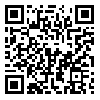Volume 11, Issue 1 (Occupational Medicine Quarterly Journal 2019)
tkj 2019, 11(1): 59-71 |
Back to browse issues page
Ethics code: IR.SSU.SPH.REC.1396.81
Download citation:
BibTeX | RIS | EndNote | Medlars | ProCite | Reference Manager | RefWorks
Send citation to:



BibTeX | RIS | EndNote | Medlars | ProCite | Reference Manager | RefWorks
Send citation to:
zarinkafsh M, halvani G, falah H, asgari M. Evaluation of static anthropometric characteristics of 2 to 6 year old children in kindergartens and preschools in Isfahan. tkj 2019; 11 (1) :59-71
URL: http://tkj.ssu.ac.ir/article-1-978-en.html
URL: http://tkj.ssu.ac.ir/article-1-978-en.html
MSc of ergonomie, Department of ergonomie, School of Public Health, Yazd University of Medical Sciences, Yazd, Iran , zarinkafsh365@gmail.com
Abstract: (2769 Views)
Introduction :The adequacy of facilities and the individual securities in their different age groups is importance to ensure greater functionality to them, allowing full development of daily activities. The present study aimed to measure body dimensions of a representative sample of children aged 2 to 6 years old Kindergarten and preschool children in the city of Isfahan compare with physical dimensions Belgium.Anthropometric variables more appropriate to design products for both the leisure activities, and for the school sector.
Methods: In this study, we measured 24 static anthropometric dimensions of 700 people sample including 350 male and 350 female in kindergarten and preschool from Isfahan aged 2–6 years usig rated vertical planes with 2*1 meter dimension, caliper with a movable jaw and tape measure .These data were analyzed by SPSS software, version 20 and descriptive statistics such as mean, standard deviation, max and min level ,median, mode and percentiles value was calculated for each dimension. Then the percentiles (5 and 95) were obtained Compared to the Belgian standard and the percentage of difference between them was determined.
Results: Descriptive static anthropometric dimensions and percentiles value were presented as an anthropometric database in 5 age group also showed genders and ages had effects in a set of 24 anthropometric dimensions.(p<0.05)
Conclusion: Age and gender are all affecting anthropometric variables. According to the results of this study, it is necessary to use the anterpometric database prepared by the same age group and country in the design of the equipment.
Methods: In this study, we measured 24 static anthropometric dimensions of 700 people sample including 350 male and 350 female in kindergarten and preschool from Isfahan aged 2–6 years usig rated vertical planes with 2*1 meter dimension, caliper with a movable jaw and tape measure .These data were analyzed by SPSS software, version 20 and descriptive statistics such as mean, standard deviation, max and min level ,median, mode and percentiles value was calculated for each dimension. Then the percentiles (5 and 95) were obtained Compared to the Belgian standard and the percentage of difference between them was determined.
Results: Descriptive static anthropometric dimensions and percentiles value were presented as an anthropometric database in 5 age group also showed genders and ages had effects in a set of 24 anthropometric dimensions.(p<0.05)
Conclusion: Age and gender are all affecting anthropometric variables. According to the results of this study, it is necessary to use the anterpometric database prepared by the same age group and country in the design of the equipment.
Methods: In this study, we measured 24 static anthropometric dimensions of 700 people sample including 350 male and 350 female in kindergarten and preschool from Isfahan aged 2–6 years usig rated vertical planes with 2*1 meter dimension, caliper with a movable jaw and tape measure .These data were analyzed by SPSS software, version 20 and descriptive statistics such as mean, standard deviation, max and min level ,median, mode and percentiles value was calculated for each dimension. Then the percentiles (5 and 95) were obtained Compared to the Belgian standard and the percentage of difference between them was determined.
Results: Descriptive static anthropometric dimensions and percentiles value were presented as an anthropometric database in 5 age group also showed genders and ages had effects in a set of 24 anthropometric dimensions.(p<0.05)
Conclusion: Age and gender are all affecting anthropometric variables. According to the results of this study, it is necessary to use the anterpometric database prepared by the same age group and country in the design of the equipment.
Methods: In this study, we measured 24 static anthropometric dimensions of 700 people sample including 350 male and 350 female in kindergarten and preschool from Isfahan aged 2–6 years usig rated vertical planes with 2*1 meter dimension, caliper with a movable jaw and tape measure .These data were analyzed by SPSS software, version 20 and descriptive statistics such as mean, standard deviation, max and min level ,median, mode and percentiles value was calculated for each dimension. Then the percentiles (5 and 95) were obtained Compared to the Belgian standard and the percentage of difference between them was determined.
Results: Descriptive static anthropometric dimensions and percentiles value were presented as an anthropometric database in 5 age group also showed genders and ages had effects in a set of 24 anthropometric dimensions.(p<0.05)
Conclusion: Age and gender are all affecting anthropometric variables. According to the results of this study, it is necessary to use the anterpometric database prepared by the same age group and country in the design of the equipment.
Type of Study: Applicable |
Subject:
Ergonomics
Received: 2018/10/9 | Accepted: 2019/07/7 | Published: 2020/04/14
Received: 2018/10/9 | Accepted: 2019/07/7 | Published: 2020/04/14
Send email to the article author
| Rights and permissions | |
 |
This work is licensed under a Creative Commons Attribution-NonCommercial 4.0 International License. |







